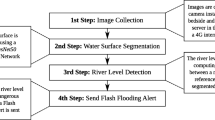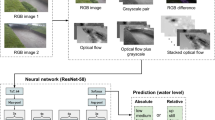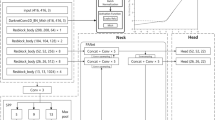Abstract
Recently, surveillance technology was proposed as an alternative to flood monitoring systems. This study introduces a novel approach to flood monitoring by integrating surveillance technology and LiDAR data to estimate river water levels. The methodology involves deep learning semantic segmentation for water extent extraction before utilizing the segmented images and virtual markers with elevation information from light detection and ranging (LiDAR) data for water level estimation. The efficiency was assessed using Spearman's rank-order correlation coefficient, yielding a high correlation of 0.92 between the water level framework with readings from the sensors. The performance metrics were also carried out by comparing both measurements. The results imply accurate and precise model predictions, indicating that the model performs well in closely matching observed values. Additionally, the semi-automated procedure allows data recording in an Excel file, offering an alternative measure when traditional water level measurement is not available. The proposed method proves valuable for on-site water-related information retrieval during flood events, empowering authorities to make informed decisions in flood-related planning and management, thereby enhancing the flood monitoring system in Malaysia.










Similar content being viewed by others
References
Akiyama TS, Marcato Junior J, Gonçalves WN, Bressan PO, Eltner A, Binder F, Singer T (2020) Deep learning applied to water segmentation. Int Arch Photogramm Remote Sens Apat Inf Sci XLIII-B2-2(B2):1189–1193. https://doi.org/10.5194/isprs-archives-XLIII-B2-2020-1189-2020
Arshad B, Ogie R, Barthelemy J, Pradhan B, Verstaevel N, Perez P (2019) Computer vision and iot-based sensors in flood monitoring and mapping: a systematic review. Sensors (switzerland) 19(22):1–28. https://doi.org/10.3390/s19225012
CFE-DM (2019) Malaysia disaster management reference handbook. Center for Excellence in Disaster & Humanitarian Assistance (CFE-DM). Retrieved from http://reliefweb.int/map/chile/chilelocation-map-2013
Costa DG, Guedes LA, Vasques F, Portugal P (2013) Adaptive monitoring relevance in camera networks for critical surveillance applications. Int J Distrib Sensor Netw. https://doi.org/10.1155/2013/836721
Costabile P, Costanzo C, De Lorenzo G, De Santis R, Penna N, Macchione F (2021) Terrestrial and airborne laser scanning and 2-D modelling for 3-D flood hazard maps in urban areas: new opportunities and perspectives. Environ Model Softw 135:104889. https://doi.org/10.1016/j.envsoft.2020.104889
DID (2018) Hydrological standard for water level station instrumentation. Kuala Lumpur, Malaysia: Department of Irrigation and Drainage (DID) Malaysia
Eltner A, Bressan PO, Akiyama T, Gonçalves WN, Marcato Junior J (2021) Using deep learning for automatic water stage measurements. Water Resour Res. https://doi.org/10.1029/2020WR027608
Fernandez-Moral E, Martins R, Wolf D, Rives P (2018) A new metric for evaluating semantic segmentation: leveraging global and contour accuracy. In: IEEE intelligent vehicles symposium, proceedings, 2018–June(March 2021), pp 1051–1056. https://doi.org/10.1109/IVS.2018.8500497
Lo S-WW, Wu J-HH, Lin F-PP, Hsu C-HH (2015a) Cyber surveillance for flood disasters. Sensors (switzerland) 15(2):2369–2387. https://doi.org/10.3390/s150202369
Lo SW, Wu JH, Lin FP, Hsu CH (2015b) Visual sensing for urban flood monitoring. Sensors (switzerland) 15(8):20006–20029. https://doi.org/10.3390/s150820006
Lopez-Fuentes L, Rossi C, Skinnemoen H (2017) River segmentation for flood monitoring. In: Proceedings - 2017 IEEE International Conference on Big Data, Big Data 2017 (vol 2018-Janua, pp 3746–3749). https://doi.org/10.1109/BigData.2017.8258373
Moy de Vitry M, Kramer S, Dirk Wegner J, Leitao JP (2019a) Scalable flood level trend monitoring with surveillance cameras using a deep convolutional neural network. Hydrol Earth Syst Sci 23(11):4621–4634. https://doi.org/10.5194/hess-23-4621-2019
Moy de Vitry M, Kramer S, Wegner JD, Leitão JP (2019b) Scalable flood level trend monitoring with surveillance cameras using a deep convolutional neural network. Hydrol Earth Syst Sci Discuss. https://doi.org/10.5194/hess-2018-570
Muhadi NA, Abdullah AF, Bejo SK, Mahadi MR, Mijic A (2020) Image segmentation methods for flood monitoring system. Water 12(6):1825. https://doi.org/10.3390/w12061825
Muhadi NA, Abdullah AF, Bejo SK, Mahadi MR, Mijic A (2021) Deep learning semantic segmentation for water level estimation using surveillance camera. Appl Sci (switzerland). https://doi.org/10.3390/app11209691
Mynett AE, Vojinovic Z (2009) Hydroinformatics in multi-colours-part red: Urban flood and disaster management. J Hydroinf 11(3–4):166–180. https://doi.org/10.2166/hydro.2009.027
Muhadi NA. (2022). Dataset For Water Segmentation [Data set]. In Deep Learning Semantic Segmentation for Water Level Estimation Using Surveillance Camera (Vol. 11, Number 20, p. 9691). Zenodo. https://doi.org/10.5281/zenodo.7269522
Oddo PC, Bolten JD (2019) The value of near real-time earth observations for improved flood disaster response. Front Environ Sci 7(September):1–11. https://doi.org/10.3389/fenvs.2019.00127
Price RK, Vojinovic Z (2008) Urban food disaster management. Urban Water J 5(3):259–276. https://doi.org/10.1080/15730620802099721
Sathish Kumar D, Arya DS, Vojinovic Z (2013) Modeling of urban growth dynamics and its impact on surface runoff characteristics. Comput Environ Urban Syst 41:124–135. https://doi.org/10.1016/j.compenvurbsys.2013.05.004
Spearman C (1904) The proof and measurement of association between two things. Am J Psychol 15(1):72–101. https://doi.org/10.1037/h0065390
UNDRR (2020) The human cost of disasters - an overview of the last 20 years 2000–2019. Human Cost of Disasters. https://doi.org/10.18356/79b92774-en
Vandaele, Remy, Dance SL, Ojha V (2021) Deep learning for the estimation of water-levels using river cameras. Hydrol Earth Syst Sci Discuss (February) 1–28
Vandaele, Rémy, Dance SL, Ojha V (2021) Automated water segmentation and river level detection on camera images using transfer learning. Lecture Notes in Computer Science (Including Subseries Lecture Notes in Artificial Intelligence and Lecture Notes in Bioinformatics) 12544 LNCS(March):232–245. https://doi.org/10.1007/978-3-030-71278-5_17
Witherow MA, Sazara C, Winter-Arboleda IM, Elbakary MI, Cetin M, Iftekharuddin KM (2018) Floodwater detection on roadways from crowdsourced images. Comput Methods Biomec Biomed Eng: Imaging Visual 1163:1–12. https://doi.org/10.1080/21681163.2018.1488223
Acknowledgements
This study was funded by Universiti Putra Malaysia under the Putra Grant, GP-IPM (Grant number: 9780100). Besides, the authors would like to appreciate the given opportunity to collaborate with the European Union under the RECONECT project funded by the European’s Union Horizon 2020 (Project ID: 776866). The authors also appreciate the support for this study from the Faculty of Engineering and the Institute of Aquaculture and Aquatic Sciences, Universiti Putra Malaysia. Lastly, the authors would like to thank the Department of Irrigation and Drainage for publicly sharing the surveillance images and water level data.
Open research
Input dataset are publicly available at the Zenodo data repository (Nur Atirah Muhadi 2022).
Funding
This study was funded by GP-IPM, Universiti Putra Malaysia (Grant number: 9780100). Besides, the authors would like to appreciate the given opportunity to collaborate with the European Union under the RECONECT project funded by the Europeans Union Horizon 2020 (Project ID: 776866).
Author information
Authors and Affiliations
Contributions
All authors contributed to the study conception and design. NAM and AFA have designed and conducted the research in collaboration with SKB and MRM, supervised by AM and ZV. NAM has written the manuscript with contributions from all co-authors.
Corresponding author
Ethics declarations
Competing interests
The authors have no relevant financial or non-financial interests to disclose.
Additional information
Publisher's Note
Springer Nature remains neutral with regard to jurisdictional claims in published maps and institutional affiliations.
Appendices
Appendix A
The screenshot of the execution of the automated procedure for Kampung Selisek using the segmentation procedure of the GUI.

Appendix B
The segmented images were saved from the execution of the automated procedure for Kampung Selisek.

Appendix C
The result was from the water level estimation procedure in the GUI.

Appendix D
Image saved from the water level estimation procedure that includes the segmented result and water level status.

Appendix E
Excel sheet that contains the information of image submitted by the user in terms of locations, date, and time as well as the estimated water level values.

Rights and permissions
Springer Nature or its licensor (e.g. a society or other partner) holds exclusive rights to this article under a publishing agreement with the author(s) or other rightsholder(s); author self-archiving of the accepted manuscript version of this article is solely governed by the terms of such publishing agreement and applicable law.
About this article
Cite this article
Muhadi, N.A., Abdullah, A.F., Bejo, S.K. et al. Deep learning and LiDAR integration for surveillance camera-based river water level monitoring in flood applications. Nat Hazards (2024). https://doi.org/10.1007/s11069-024-06503-6
Received:
Accepted:
Published:
DOI: https://doi.org/10.1007/s11069-024-06503-6




